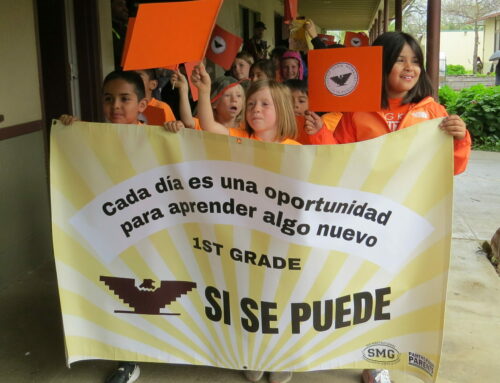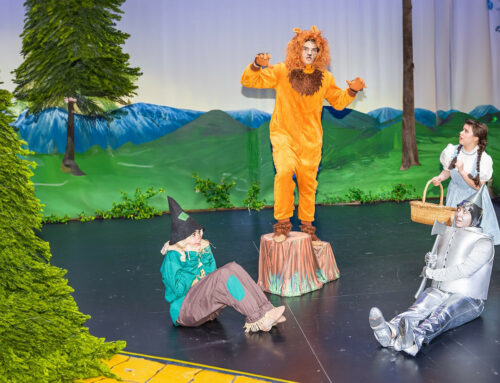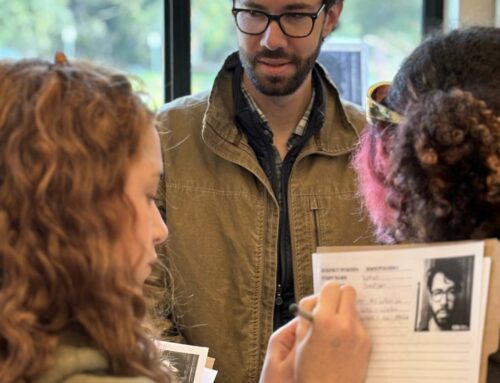Martin Murphy students build team work and logic skills through coding
Published in the December 7 – 20, 2016 issue of Morgan Hill Life
By Marty Cheek
Someone visiting Martin Murphy Middle School might find students flying aerial drones through hula-hoops or maneuvering terrestrial drones through an obstacle course of pool noodles and mistakenly believe the kids are simply playing games. But these gadgets are helping the students master engineering values — including logic flow, team work and creative thinking — while they develop basic computer coding skills.
Among them are Tarun Bedi and Jackson Morita, both 13-year-old eighth graders, who are in the Mouse Squad group that helps students and teachers with technology problems. On a November morning, the two assisted students preparing for a series of competitions on how to race aerial drones through a course of hula-hoops hanging from the ceiling.
“It teaches you how to code and use different apps with software,” Bedi explained.
Jackson added, “We’re just teaching kids how to code pretty much, like how to troubleshoot and control something with code.”
The Martin Murphy students are learning to code in programming languages C++, Java Script, Python, and Square, he said.
“It’s teaching them to troubleshoot,” Bedi said. “If they don’t know how to do something, they have the students go to Google (online) and search for the answer before they talk to us.”
The students learn critical thinking and logic by programming. They also learn engineering skills on how to test the program to find faults, fix them, and test again, he said.
“Here it’s just trying and trying until you get it done,” he said. “Then when they get it right, they perfect it by fine-tuning it.”
Bedi is thinking about a career as a software engineer and maybe one day working at Intel or Google. Jackson wants to be a basketball player, but he also considers the option of working on software programming as a job.
The students use Chromebooks purchased by Measure G bond money to program the remote-controlled devices, said Martin Murphy Principal Alex Aasen.
“What they’re doing is on the tablet giving it a set of instructions to go around the obstacle course,” he said. “So they’re learning how to do drop-block programming. What they’re doing is going through the engineering process and learning to trouble shoot to make the drone go through the course. So there’s a whole process they’re learning.”
David Martinez, a Martin Murphy computer teacher, explained how the students learn that in the engineering world failure is feedback. Some kids didn’t have their drones go successfully through the obstacle course, but Martinez emphasized to them that they didn’t actually “fail,” they just didn’t make it through. If something doesn’t work the first time, the students can figure out the problem and use that information to make changes in the system to try to correct the fault, he said.
“It gives them a hands-one perspective of what real engineers go through so that we can lean them toward that path,” he said. “They also learn that failure is OK because that’s how we learn…. It’s a process of brainstorming, figuring out what the problem is, redesigning, testing and then starting all over again.”
The drone programming activity is part of the project-based learning system the Morgan Hill Unified School District is developing at many of its schools, including its elementary schools and focus academies. Students learn team work and communication skills which are valuable assets in real-world careers, Martinez said.
“Each student has a role,” he said. “One person is recording the time as they’re going through. Some are coding the device. And the people who are doing the code, they do it and then they pass it off to the next person and share it. They want to do it all the time because it’s fun for them, but to give it to someone else teaches them how to share.”
The Martin Murphy staff are also getting feedback from the students. Because the drone coding program is so new, the teachers are learning “on the fly” on how to teach it to the young people, he said.
“There’s not curriculum for this. We’re kind of just making it up,” he said.
For the students, learning with the drone competitions is fun so they stay focused, said MHUSD Superintendent Steve Betando.
“The best part is how quickly they get engaged. And it also stimulates their curiosity,” he said. “What you see are hands-on activities where the kids are actually applying what they learned in the classroom. The kids go through a series of activities and test the programs to see if they have applied their skills correctly to do different things.”
What might seem like students just having fun with drones will help these potential engineers build the skills they need in the job market, said Aasen
“It’s great that the kids have this opportunity now, not to mention the fact that everything in our future is going to be controlled by coding different objects,” he said. “A big part of the engineering process is working in a team. That team work (aspect) is a targeted skill that we’re designing into the curriculum. It’s not just fun, it’s very purposeful.”






